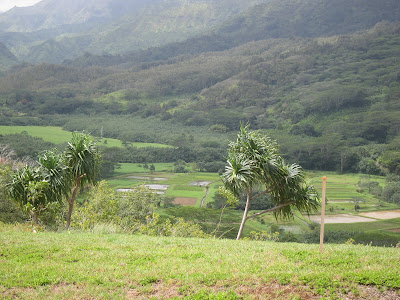So
weird, how Hawaii researchers go to great trouble and expense to
again confirm what has been known for decades — feral cats and rats
prey heavily on ground-nesting birds — yet so little is
being done to address it.
So
weird, how Terry Lilley continues to make totally bogus claims, yet
is still treated as a credible source on coral disease by our local
newspaper. Most recently, Lilley boldly — and falsely — stated that Waipa Foundation had released “tons of toxic mud” into Waipa Stream and “illegal
digging at Waipa is killing the corals” on Waikoko reef. In fact, Waipa has all its permits for the new building under construction there, and a recent check by the state Department of Health found
no violations. What's more, 10 years of water
monitoring show Waipa estuary is significantly cleaner today than it
was a decade ago, due at least in part to better land management
activities implemented by Waipa Foundation.
So
weird how Kauai County has a revered governing document known as the
charter, but like our planning department, it functions only on a
complaint basis. In other words, if you're upset that former Planning
Director Ian Costa executed a landowner-friendly agreement without
the mayor's signature, or that former first deputy prosecutor Jake
Delaplane got his job even though he didn't have the required
experience, you have to make a complaint to the Board of Ethics and
wait months for a decision that most likely will amount to nothing,
or perhaps a slap on the wrist. So what, really, is the point of
having a charter when it can be violated pretty much with impunity?
So
weird, how biotech scientists are mutating animals in a supposed
search for the cause of Alzheimers, Parkinson's, cancer, when those
diseases may well be caused by the chemicals, particularly those
found in RoundUp, that are used so heavily on the biotech crops that
were supposedly developed to solve the world's food woes, as this research paper convincingly argues.
So
weird, how we're playing God, when we don't even fully understand
this beautiful, complex planet and remain largely in denial about the
havoc we're wreaking upon it with so many of our clever inventions. Speaking of
which, the European Union has approved a two-year restriction on
using three neonicotinoids — pesticides made
by Bayer and Syngenta, and implicated in the decline of
honeybees — on flowering crops. As the Independent reports:
The
issue has fiercely divided the scientific community.
Professor
Lin Field, head of biological chemistry and crop protection at
Rothamsted Research, said he feared the decision was based on
"political lobbying" and could cause governments to
overlook other factors contributing to declining bee numbers, such as
climate change and viruses spread by mites.
But
Dr Lynn Dicks, a research associate at the University of Cambridge,
said that despite the contradictory studies, the EU was right to err
on the side of caution. "This is a victory for the precautionary
principle, which is supposed to underlie environmental regulation,"
she said.
So
weird how we get all cautious about liquids on airplanes and bike
helmets and second-hand smoke while ignoring or downplaying all the social degradation and environmental contamination generated by what we now deem “progress.”
So
weird how dandelions, once cherished as a nutrient-dense springtime green, are
now considered a scourge to be poisoned by those who instead purchase
pre-chopped iceberg lettuce bagged in plastic and multivitamin pills.
So
weird how the state “improves” the Kalalau Trail, which
encourages more clueless hikers to use it, and then completely fails
to manage it, but freaks out when people who should never be there do use it and get
hurt. Kauai firefighters are now getting up to three rescue calls per
week from the trail, which puts their lives unnecessarily at risk. As KITV reports, the state is looking to adopt more controls, like perhaps
limiting the number of visitors in the park and on the trail —
hello! — and stationing a ranger at the trailhead to dissuade dummies. Kauai Fire Capt.
Sam Lee Jr. is quoted as saying:
“All
it really takes sometimes is somebody to warn somebody, hey, just be
careful and maybe we can save somebody.”
If
only. I don't know about you, but I've warned countless tourists
about the dangers of waves, reefs, trails, sun, dogs, what have you.
And invariably the response is some version of piss off, beat it,
mind your own business, I know what I'm doing.
So
weird, that human propensity to ignore clear warnings, engage in foolish behavior, and then cry, "save me!"












































